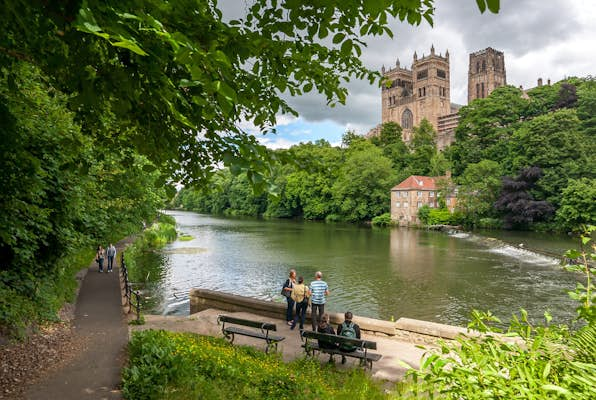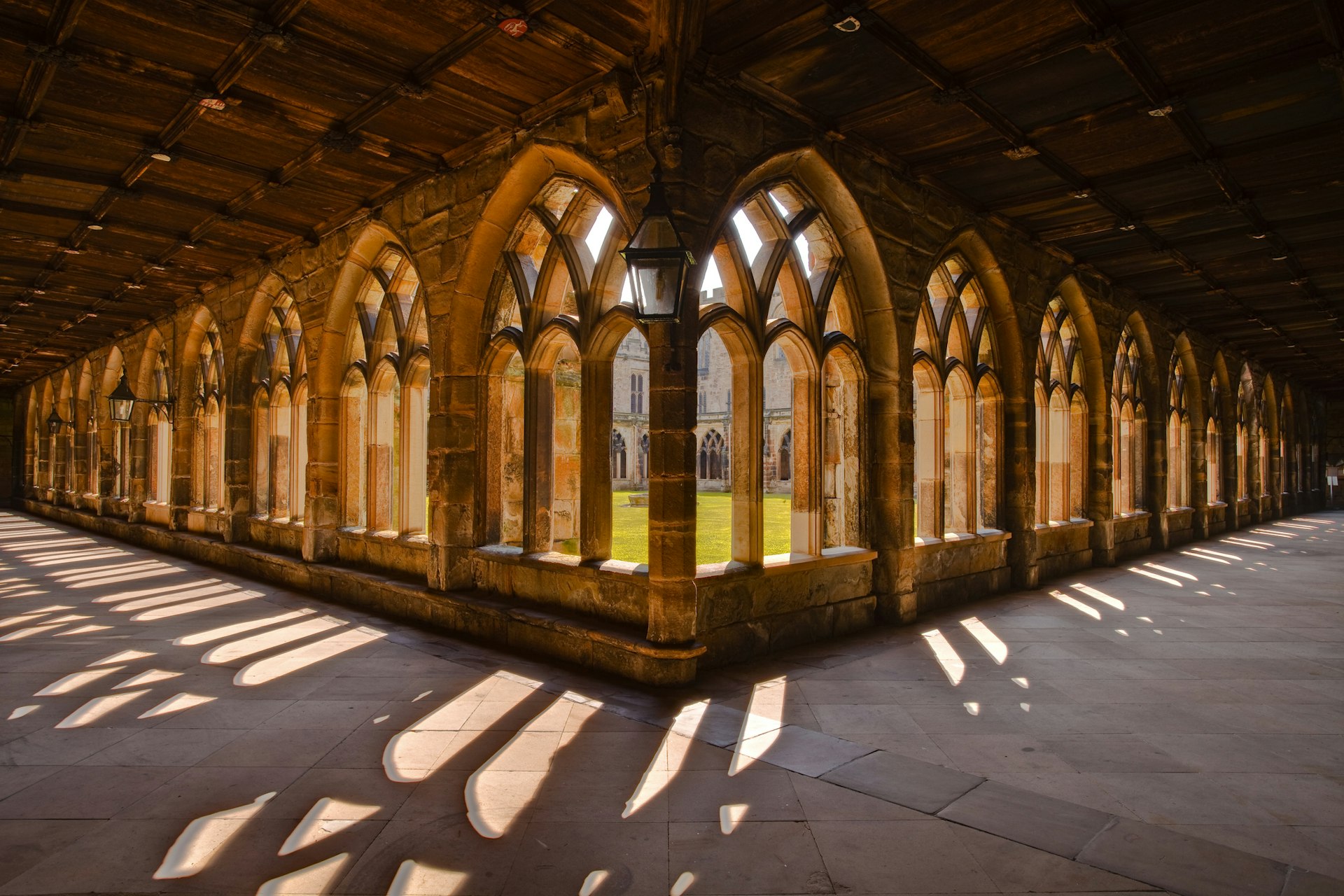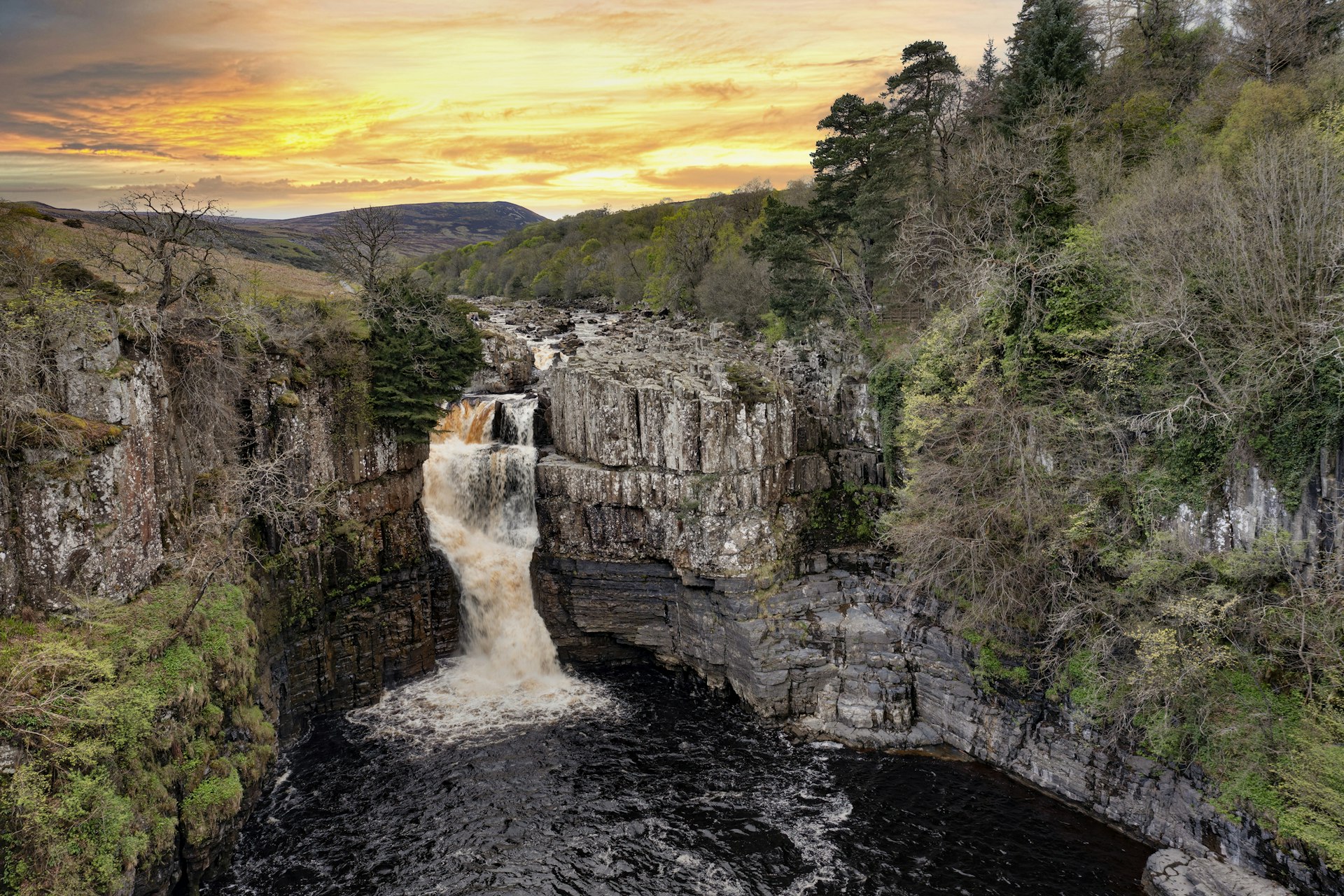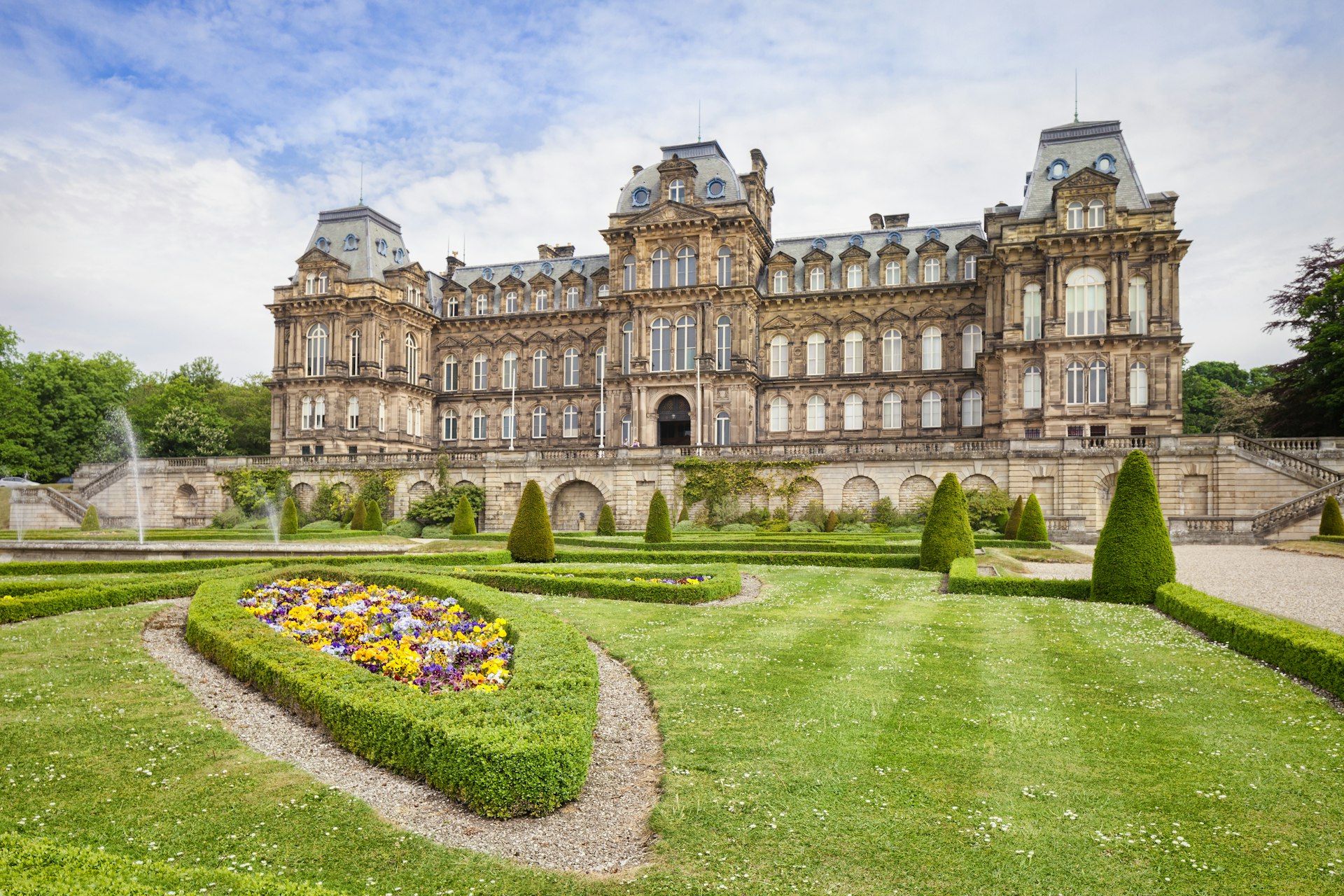
Sitting just south of Newcastle-upon-Tyne, with its bridges, castles and football rivalries, and north of the windswept beauty of the Yorkshire Dales and North York Moors, it’s easy to overlook Durham on a visit to the northeast of England.
But with a charismatic old town that has been designated a Unesco World Heritage Site, and on the doorstep of the North Pennines Area of National Beauty, Durham has plenty of charm and appeal of its own, and will reward anyone looking to venture from the better-known hubs of the region.
From touring Durham Cathedral to walking through the Dales, here are some of the best things to do in England’s County Durham.
Make the most out of every adventure with help from our weekly newsletter delivered to your inbox.  Durham Cathedral’s cloisters have doubled as Hogwarts in the Harry Potter movies © Julian Elliott Photography / Getty Images
Durham Cathedral’s cloisters have doubled as Hogwarts in the Harry Potter movies © Julian Elliott Photography / Getty Images
Explore every corner of Durham Cathedral
Visible from wherever you stand in Durham city, Durham Cathedral is an impressive Norman structure, dating from the 11th century. The cathedral was originally built to house the the Shrine of St Cuthbert, still there at the east end of the building. There’s plenty more to interest current visitors, whether they’re absorbed by the history, want to stand where some of their favorite films were shot (including Avengers: Engdame and two Harry Potter films), or enjoy the artistry of the stained glass windows. The interior is intricate and peaceful, and with volunteers available to offer information at every point, there’s no shortage of opportunities to hear about the history and features of the cathedral.
No visitor should miss the cloisters, or “monks’ walk”, maybe best known as Hogwarts in the Harry Potter movies. Used by the Benedictine monks who used to live on the grounds, the area is especially enjoyable if it’s warm enough to sit and absorb the peaceful atmosphere.
For those who have the time (and the legs), take a tour to the top of the tower, available on the hour until 3pm. Once you’ve regained your breath, you’ll be able to appreciate the amazing views of the county in four directions. But don’t stay late or you’ll be stuck up there; the door to the winding staircase is locked at 4pm. Local folklore says that students from Durham University shouldn’t climb the tower before they graduate; if they do they will fail their exams. Those who wish to see the stunning panoramic views of the city need to wait until at least the day of their graduation.
Visiting the cathedral is ostensibly free, with a £5 voluntary donation, and an extra charge to enter the museum or the tower.
 Hike accessible routes through a designated Area of Outstanding Natural Beauty © Dark_Eni / Getty Images
Hike accessible routes through a designated Area of Outstanding Natural Beauty © Dark_Eni / Getty Images
Walk the Durham Dales
A visit to County Durham is not complete without spending some time in the spectacular Durham Dales, which make up part of the Northern Pennines Area of Outstanding Natural Beauty (AONB), a designated Unesco Global Geopark. The dales are home to old castles, meandering rivers, waterfalls, wildlife and picturesque villages. There are great options here for cycling, hiking, kayaking and stargazing.
The High Force Loop is an accessible, enjoyable route for those of reasonable fitness, taking in waterfalls, grazing sheep, gates and stiles and an old thieves’ hideout. There are shorter loops too, and for those with little ones the initial part of the High Force Loop has woodland sculptures (a fox, an owl, a hare) hidden throughout the forest for them to spot as you ramble on.
For something more strenuous, the full loop past Low Force waterfall is 12km (7.5 miles), or can be pushed out to 16km (10 miles) if you decide to take in the Gibson’s Fall detour at Bowlees. Much of the walk is accompanied by the sound of the pounding waterfalls, and once you move from the forest to the fields you’ll be sharing the path with sheep and soaking in pastoral views in every direction.
Bowlees village is the jumping off point for a detour to Summerhill Force, about halfway through the hike just before you turn south to walk back on the opposite side of the riverbank. The recess beneath the waterfall is known as Gibson’s Cave, after the 16th-century outlaw William Gibson who went on the run and hid out there under the waterfall. Legend has it that locals would bring him food and supplies, and help him hide from the law.
The second half of the hike takes you past Low Force waterfall, a broad, hypnotic cascade, and through flat land on the south side of the river. And afterwards, the High Force Hotel is perfect for a restorative drink, with a crackling open fire, gigantic scones, and local ales on tap.
 The Bowes Museum has an incredible and varied collection of art and design © travellight / Shutterstock
The Bowes Museum has an incredible and varied collection of art and design © travellight / Shutterstock
Discover the eclectic collection at Bowes Museum
Another draw to the region, and an excellent place to spend a day in Durham, is the Bowes Museum in Barnard Castle. Built by Joséphine Bowes and her husband John, and opened in 1892, the museum houses an eclectic mix of paintings, porcelain, clocks, and personal items of the founders. Favorites include Marie Antoinette’s writing desk, an ingenious contraption with a mirror on the underside of the desktop that can be slid up when required, and an original Goya.
The main draw is the famous 247-year-old silver mechanical swan, the inspiration for the museum’s logo. Made by James Cox, an 18th-century jeweler, with an internal mechanism designed by John Joseph Merlin, the clockwork mechanism makes the swan move in an uncannily natural manner. Bought by John for £200 (over £28ooo in todays pounds) after he witnessed its magic at the Paris International Exhibition, it is still operational today.
The swan is not the only piece in the museum that can be considered a steal; there are some paintings hung here that have increased exponentially in value since they were bought by the Bowes. The paintings include El Greco’s The Tears of Saint Peter, and two works by Canaletto, both of which were bought for a song and are now worth millions.
The grounds are another feature of the museum worth your time. The view from the front door of the manicured gardens with the Dales in the background are more beautiful than anything inside, and the woodland walks and picnic areas surrounding the museum are very popular with families.
Neither John nor Joséphine saw the finished museum, but it’s a staggering monument to love, unconventionality, and the joy of beautiful things.
Take part in the regeneration of a town
Bishop Auckland, southwest of Durham city, is home to a fascinating regeneration project that is well worth an afternoon’s exploration. Jonathan Ruffer, an investment banker and philanthropist, moved from London back to Bishop Auckland in 2012 with the desire to do some good for his hometown. The regenerative project has been undertaken thanks to his largesse and enthusiasm.
The main part of the project lies in Auckland Castle and grounds, the old seat of the powerful Prince Bishops. The last bishop moved out in 2012, and the castle is now being turned into a museum. The rooms depict the lives of different bishops throughout different periods of time, with recordings, projections and replicas all used very effectively to evoke the feeling of each era. The centerpiece is the dining room, with the Jacob and his Twelve Sons painting series by Francisco de Zurbarán along all four walls. The grounds are also open to the public, with a deer park, a number of gardens and a Faith Museum currently under construction. Anyone lucky enough to visit the castle during the festive season should make sure to take a look at the fascinating and eerie Neapolitan Nativity.
Another feature of the regenerative project is the Spanish Gallery, on the main square of Bishop Auckland. It’s a small, but well laid out, tasteful, and thoughtfully curated gallery, and one of the UK’s largest collections of 16th- and 17th-century Spanish artworks. Particular favorites are the Adoration of the Magi (Luca Giordano) and The Penitent Magdalene (Juan Bautista Maíno). The gallery also has some interesting replicas on the top floor, of tiled rooms in the old Spanish style, a noble’s tomb, and more. And keeping with the Spanish theme, neighbouring El Castillo is the perfect spot for lunch, with excellent tapas.
Another part of the regenerative project is Auckland Tower, a modern climbable tower just outside the palace gates, in the main square of Bishop Auckland. Designed as a medieval tower, and supposedly symbolizing the link between the people of the town and the castle, it’s a curious addition to the complex, but the views from the top are lovely.
How to get to Durham and where to stay
Durham city is a 35-minute drive from Newcastle airport, and is a great place to base yourself for a trip to the broader county. There are a range of accommodations, and all the food and nightlife opportunities that can be expected in a university town.
If you venture out into the Dales for an overnight stay, you’ll find cozy inns and hotels tucked away in picturesque villages, such as the Rose & Crown in Romaldkirk. There are restaurants offering local produce, and plenty of warm pubs to quench your thirst after a day of hiking over the moors.
A car is the best way to get around County Durham, available for rent from Newcastle airport. A train links the airport to Durham city via Newcastle center.
Amy Lynch traveled to Durham at the invitation of Visit County Durham as part of the Durham Memorable Moments campaign.



